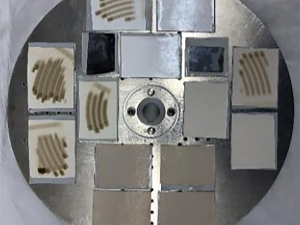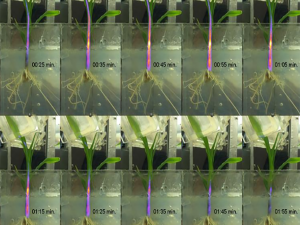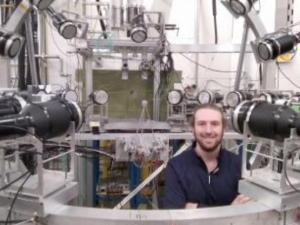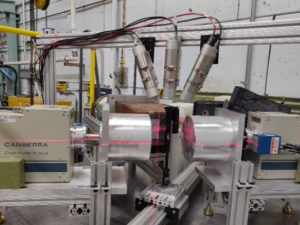Applications of Nuclear Physics at TUNL
The research infrastructure at TUNL that is optimized for advancing the frontiers of nuclear physics creates opportunities for contributing to development of techniques and technologies that address current societal needs and for interdisciplinary research. The scientific interests and expertise of research groups in the TUNL consortium along with the rich educational environment facilitates spin-off research in applied areas, e.g., national nuclear security, homeland security, isotope development, plant biology and water purification. The work in national security and isotope development research involves measurements of nuclear reactions on many-body nuclei that overlap substantially with the intellectual motivation and experimental techniques of the nuclear structure program at TUNL. The research in plant biology and water purification is carried out in collaboration with scientists in other disciplines. Examples of current applied and interdisciplinary research are given below.
Projects
Rutherford Backscattering Studies of Water Purification Membranes
A large future environmental challenge, especially in increasingly arid climates, will be providing pure drinking water for growing populations. Highly engineered polymer membranes are used increasingly for nanofiltration and desalination to meet these fresh water needs. In our research for improved membranes, Rutherford backscattering of 2 MeV helium beams at TUNL provides unique characterization advantages because the incident helium ions penetrate deeply into the membrane, compared with other analysis techniques that are only surface sensitive. The photo (on right) shows membrane samples mounted on the beam’s target wheel used for these studies. Stationary beam on a sample deposits enough energy to burn the membrane at that spot and invalidate data collected. Thus, samples are moved by rotating the wheel under computer control to scan the incident beam across the sample until statistically sufficient results are accumulated. Short semicircular arc patterns seen on samples are thus only slightly darkened.
The Project Team: O. Coronell (UNC), T.B. Clegg and H. Karwowski (TUNL/UNC), Richard Longland (TUNL/NCSU)
Research website: Coronell Research Group,
Publication: P.J. Attayek, et al. Nucl. Inst. and Meth. A676, 21 (2012)
Plant Physiology Studies Using Radioisotopes
An interdisciplinary collaboration is using radioisotope labeling to investigate the dynamical responses of plants to changes in environmental conditions, e.g., concentration of atmospheric CO2, nutrient availability, light intensity and temperature. The approach is to identify cause-effect relationships between changes in environmental conditions and responses that are manifested as shifts in the allocation of substances by the plant. The measurement method is based on tagging sugars and minerals with short-lived radioisotopes that can be imaged using positron emission tomography (PET) or beta particle detection. The radioisotopes are produced in the tandem laboratory at TUNL and the labeling measurements are carried out at the Phytotron, an environmentally controlled facility for plant research at Duke University. A PET image sequence taken on a corn plant is shown in Fig. 1. These frames illustrate the capabilities of this technique to determine the relative sugar allocations throughout the plant and substance transport parameters. A photograph of the setup is shown in Fig. 2.
Also, these experimental technique and research infrastructure are used to study the interactions between roots and organisms in the soil. Preliminary measurements are performed to investigate the influence of various species of fungi with corn roots with the aim of isolating those microorganisms that are most beneficial in boosting plant productivity. In addition, the collaboration is developing techniques for producing and using other short-lived radioisotopes to trace nitrogen and iron absorption in root tissues.
|
|
|
National Security
Nuclear fission has the phenomenological complexity and richness that are characteristic of many-body systems of strongly interacting particles. Challenges in modeling the process involve treating the confluence of surface science with nuclear collective phenomena and shell effects of highly deformed nuclei. Advances in the theoretical treatment of nuclear fission and applications of fission in energy and security technology and in rare isotope research are driven by accurate data for fission observables such as fission product yields, kinetic energy distributions of fission yields, and neutron emission cross sections. Beta-delayed gamma-ray spectroscopy is a potential method for quantifying fissile or fissionable isotopes in assaying nuclear fuel or spent fuel assemblies. The technique is based on the observation that the distribution of short-lived fission products generated by neutron or photon induced fission is characteristic of the fissile or fissionable nucleus.
Research at TUNL is producing new data for the fission product yields (FPYs) of isotopes with half-lives less that 60 s and for the double differential cross sections of the prompt emitted neutrons from photon and neutron induced fission of uranium and plutonium isotopes. This work is providing accurate FPY data for neutron induced fission and the first FPY measurements performed using mono-energetic gamma-ray beams.
|
|
|





